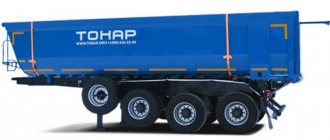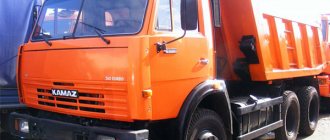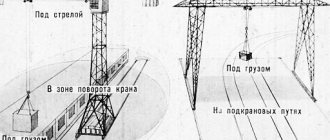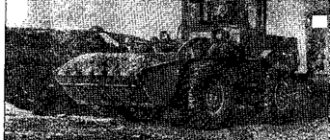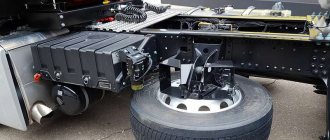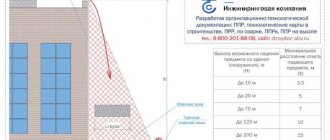To transport large and heavy cargo, carrier companies often resort to road trains. This type of equipment allows you to minimize costs by reducing the number of flights, reducing the need for drivers and saving fuel.
However, heavy vehicles can damage the road surface, so special requirements are placed on them. The weight of a road train equipped with goods must not exceed the parameters specified in the traffic regulations.
In the article we will talk about how to independently calculate the load on the axles of a road train, what formulas logisticians use for this, and what is the maximum weight of road trains allowed in Russia and Europe.
Basic weight parameters of a road train
Road train weight parameters.
The total weight of a large vehicle includes several components. The first is the permissible mass.
This parameter considers the total weight of the road train and the cargo that is planned to be placed in it.
However, the necessary calculations do not end there: before the trip, it is important to correctly calculate the load on each of the axles of the truck (in the option we are considering, there are usually 5 or 6 of them).
What is the permissible weight of a road train for the Russian Federation? Who can calculate the axle load of a road train? Let's take a closer look.
Permissible weight
This criterion is prescribed by law for each type of vehicle. Thus, for three-axle trucks the maximum permitted weight is 28 thousand kilograms, for four-axle trucks - 36 thousand, for five-axle trucks - 40 thousand, for six-axle trucks - 44 thousand kilograms.
As we noted earlier, the weight of the road train itself should be subtracted from the norms established by law. It is usually indicated in the technical passport of the truck. If the document is lost, you can download the technical specifications from the manufacturer’s official website (they are presented in Excel tables).
Several types of road trains are common in Russia, the most popular being the equipment of the Man and KamAZ companies. The weight of the Kamaz 65115 log truck train, depending on the configuration, is 24 or 38 tons. We subtract this figure from the allowed forty-four. It turns out that without penalties, KamAZ can transport 20 (44 tons minus 24) or 6 (44 tons minus 38) tons of cargo.
Axle load
This is the second criterion that is important to pay attention to before setting off on a flight. Large equipment puts pressure on the road surface and can ruin it if the load on the asphalt is distributed incorrectly. The load can be calculated using the axle load calculator for tractors and semi-trailers.
All permissible loads are specified in the second appendix to Government Resolution No. 272. According to the document, the front axle of the tractor accounts for no more than 10.5 thousand kilograms, and the rear axle – 11.5 thousand kilograms. The maximum permissible load on each of the semi-trailer axles is 8 thousand kilograms.
European emission standards for diesel truck engines
UN General Assembly emission requirements for heavy trucks equipped with a diesel engine, g/(kW • h) Each truck must be marked in accordance with its standard. Letters of the Latin alphabet are used for designation.
| Standard (year) | Carbon monoxide - CO | Hydrocarbons – HC | Nitric oxide – N0x | Soot – PM | Smokiness – Smoke |
| Euro 0 (1988) | 11,2 | 2.4 | 14,4 | — | — |
| Euro 1 (1992) | 4,5 | 1,1 | 8,0 | 0,36 | — |
| Euro 2 (1996) | 4,0 | 1,1 | 7,0 | 0,15 | — |
| Euro 3 (2000) | 2,1 | 0,66 | 5,0 | 0.10 | 0,8 |
| Euro 4 (2005) | 1,5 | 0,46 | 3,5 | 0,02 | 0,5 |
| Euro 5 (2008) | 1,5 | 0,46 | 2,0 | 0,02 | 0,5 |
| Euro 6 (2013) | 1,5 | 0,13 | 0,5 | 0,01 |
A vehicle that meets the relevant requirements is indicated by a letter placed on the cab or bumper of the truck:
- U – “Umwelt” (“Nature”), Euro-1 standard,
- E – “Green Lorry” (“Green Truck”). The concept of “Green Lorry” includes the following requirements: pollutant emission standards EURO-2, noise standards - 78-80 dBA. A certificate of conformity is filled out on such a truck and a U or E plate is installed.
- S – “Supergreen” (“Very green”), Euro-2 standard
- G - "Greener and Safe Lorry"
- L - "Larmarm Kraftfahzeuge" (low noise tractor) in Austria, since December 1, 1989, a truck driving at night (from 22:00 to 5:00) in Austria must comply with these noise standards.
Since 2001, another definition of a motor vehicle has been introduced - “EURO-3 safe”, it has been in force since 2002. Such a truck must comply with EURO-3 emissions standards, and the usual noise level is 78-80 dBA. Then a green sign with a white border and a white number 3 is hung. For cars that comply with “EURO-4” and “EURO-5” the signs are green with a white border and the numbers 4 and 5.
All of the above signs must be confirmed by a certificate from the manufacturer and be on board the vehicle.
Calculating the weight of a road train
In order for weight control to pass without any unpleasant surprises, it is important to learn how to determine the total weight of the truck and the axle load. The two indicators are directly dependent on each other.
The parameters are calculated using online calculators and useful programs presented on the websites of carrier companies. If you don’t have Internet access, you can “tweak” the characteristics yourself.
Step-by-step calculation instructions
So, the mass of a road train and the load on its axles are interrelated. The diagram looks like this: mass (m) is equal to the load on the front axle (A) plus the load on each of the axles (N).
M = load A + load N + load N1, N2, N3, N4, N5.
Examples
Calculation of axial load.
For clarity, let's look at the calculations for a specific car.
The road train has a total weight of 24 tons, the goods weigh 14 tons, and the truck has 4 axles.
First, let’s find out the weight of the loaded equipment:
24 tons + 14 tons = 38 tons.
Next, this parameter must be divided by the number of axes (4):
38:4=9.5 tons.
Let's look at the table that we mentioned earlier (Resolution No. 272). According to the document, the axles should weigh no more than 8 tons, but in our case there are two axles - the front and the rear. For them, the permissible load is greater, so there will be no overload at the control.
Terms used in transport documents
- “Truck” is a vehicle equipped with a mechanical drive. Operated for transporting goods by road;
- “Vehicle” is a device on which cargo or passengers are installed for their transportation on roads;
- “Road train” is a combined vehicle consisting of a truck and trailer (trailer train), tractor and semi-trailer (trailer train);
- “Tractor” – a vehicle equipped with its own engine and intended exclusively or primarily for towing a trailer or semi-trailer;
- “Combined vehicle” – a combination of a car and a trailer (semi-trailer);
- “Full trailer” trailer with drawbar - a towed vehicle having at least two axles, of which at least one axle is steerable and, in addition: - equipped with a towing device (drawbar) that has the ability to be vertical in relation to to the moving tractor; - not transmitting any significant vertical load to the tractor (no more than 100 daN). When a semi-trailer is coupled to a semi-trailer undercarriage, it is considered a full trailer;
- “Semi-trailer” is a towed vehicle that is designed to be connected to a truck tractor (or to the support bogie of a semi-trailer) and transfers a significant vertical load to the tractor’s coupling device (or to the support bogie of a semi-trailer);
- “Semi-trailer undercarriage” – A trailer with a center axle and equipped with a fifth-wheel hitch.
- “Maximum length of a vehicle” – the length of a vehicle that does not exceed the established permissible values (different for each country);
- “Maximum vehicle width” – the width of the vehicle, which does not exceed the established permissible values (different for each country);
- “Maximum height of the vehicle” – the height of the vehicle, which does not exceed the established permissible values (different for each country);
- “Maximum vehicle weight” – the weight of a vehicle with or without cargo, which does not exceed the established permissible values (different for each country);
- “Maximum axle mass” – the mass transmitted through the vehicle axle to the surface of the road, which does not exceed the established permissible values (for each country);
- “Weight of a vehicle in running order” is the weight of an unladen vehicle with a body and a coupling device in the case of a tractor-bus, or the weight of a chassis with a cab, if the manufacturer does not install a body, and/or a coupling device. This weight includes coolant, oils, at least 90% fuel, 100% other fluids (excluding used water), tools, driver (75 kg), and spare tire.
- “Technically permissible maximum weight of a vehicle” is the maximum weight of a vehicle, determined by its design and specified characteristics, established by the vehicle manufacturer.
- “Indivisible cargo” – cargo that cannot be divided during transportation due to the risk of damage or high costs of time and money;
- “Air suspension” is a suspension system in which the shock-absorbing element is air, providing at least 75% of the shock-absorbing effect;
Weight check
The law assigns the implementation of control measures to traffic police inspectors. The check can take place at a stationary checkpoint (points are usually located at the entrance to populated areas) and at a mobile one.
The check itself is divided into two types:
- Dynamic. In this case, the road train is “driven” through a certain area equipped with special devices. The speed of the truck is 5 kilometers per hour. With this method, an error of up to 3 percent is allowed.
- Statistical. With this option, the loaded car is placed on special scales. The equipment is stationary, the measurement results are more accurate.
International Classification of Freight Vehicles (ATC)
| Category | Type | Gross weight (tons) | Notes |
| N1 | Vehicles with an engine intended for the transportation of goods | Up to 3.5 | Trucks, special vehicles |
| N2 | Vehicles with an engine intended for the transportation of goods | Over 3.5 to 12.0 | Trucks, tractor units, special vehicles |
| N3 | Vehicles with an engine intended for the transportation of goods | Over 12.0 | Trucks, tractor units, special vehicles |
| 01 | ATS without a driver | Up to 0.75 | Trailers and semi-trailers |
| 02 | ATS without a driver | Over 0.75 to 3.5 | Trailers and semi-trailers |
| 03 | ATS without a driver | Over 3.5 to 10.0 | Trailers and semi-trailers |
| 04 | ATS without a driver | Over 10.0 | Trailers and semi-trailers |
Permitted overload
Federal law number 275 allows a slight overload on the axle. However, it should not exceed two percent. The only exception is equipment belonging to the country's Armed Forces. There are no fines for these departments.
It turns out that more than 44 thousand kilograms cannot be transported on Russian roads without sanctions? No! A road train may weigh more, but a special permit must be issued for its safe passage. The document indicates the truck's route, departure and arrival times. The paper is issued by the Traffic Inspectorate.
Restrictions
There are a number of other requirements for road trains, tanks and other cargo vehicles that do not relate to weight. The rules concern the dimensions of heavy trucks, namely their length and width.
Acceptable values are specified in the traffic rules. In different states, the parameters may differ slightly from each other.
In Russia
In our country, the length of a road train should not exceed 20 meters. The maximum height is 4 meters from the road surface. If the equipment meets the parameters, movement on all roads of the Russian Federation occurs without restrictions and special permits.
In Europe
In the USA and Europe the requirements are stricter.
The length of a tractor with a semi-trailer must not exceed 16.5 meters. In addition, all heavy vehicles are subject to a toll for road use. Each driver or transport company is assigned a registration number, which, by entering it into the database, inspectors verify tax payment.
Classification of trucks by purpose
All trucks can be divided into the following popular categories based on body type:
- Awnings and semi-trailers are the most common type of truck. Used to transport any cargo. The body is loaded from any side, which greatly simplifies this process. Average load capacity varies from 20 to 25 tons;
- Refrigerators , semi-trailers are semi-trailers that are equipped with refrigeration units necessary for transporting perishable products. Refrigerator temperature: from +25 to -25. The average carrying capacity of these types of trucks is 12-20 tons;
- An automatic coupler consists of a car and a trailer attached to it. They are very convenient in terms of loading/unloading. They can transport almost any cargo, except for long ones, as well as those requiring special conditions. Capacity: from 16 to 25 tons;
- Jumbo are high capacity trailers. The floor of the trailer is made in the shape of the letter “L”, and the diameter of the wheels is also reduced, due to which additional space is achieved. The average carrying capacity of such trailers is up to 20 tons;
- Container ship is a vehicle used for transporting containers;
- Tank truck is a vehicle used for transporting liquid and bulk cargo;
- Car carrier – a vehicle used for transporting cars;
- Grain carrier – a vehicle used for transporting grain;
- A dump truck is a vehicle used for transporting bulk cargo.


